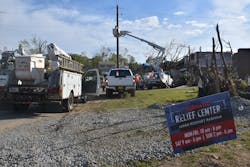The real work truck show
TBB’s April cover image has come from the exhibit hall of The Work Truck Show for as long as NTEA has produced the ever-bigger event.
But instead of the latest, greatest, and oh-so-shiny showroom examples of commercial vehicles, this month we have a truck that’s obviously well used—and in use.
Simply, there’s nothing like a tornado leaving a half-mile-wide gash through the lovely, ridge-lined residential heart of your community to draw attention to the important things. And I’ve been so impressed with the work being done in Little Rock by people who use the equipment TBB readers design, manufacture, and distribute—no way could I seriously consider a truck-show glamour shot for the cover.
Here's the miracle (thank you, too, Doppler weather radar): There were only a couple fatalities from a storm that took the roofs off thousands of structures, tossed around vehicles, uprooted century-old oaks, and snapped towering loblolly pines. It’s going to be a hot, shadeless summer in many neighborhoods as folks rebuild.
My family was lucky. Those in town live only a block or two to either side of the destruction. My street never even lost power. So, after waiting a week to give the first responders, linemen, wreckers, cranes, dumps and claims adjusters time to make the rounds, I ventured out.
Grabbing a camera with a big lens and a lanyard with a passable press ID, I put on a worn-one-time, hi-viz yellow safety vest over a work shirt, along with a trucking-stickered hardhat that has a warning label inside that says it’s not a real hardhat.
Other than being cautioned about the risk of flat tires by flagmen managing the flow on one-lane-only roads—nails apparently fall from debris loads faster than streetsweepers can make the rounds—I didn’t meet any official resistance to my getting around in search of work trucks.
As anyone who’s been on the ground after a natural disaster discovers, chainsaws and generators gradually repace the sound of sirens. But the big difference between watching drone coverage and taking the sidewalk comes from up-close details—the personal items scattered across wrecked neighborhoods: clothes, books, knickknacks.
Then you think about the now-homeless families. Or we should. But here’s what makes tornadoes so absurd: It’s like the devil’s throwing darts; you have to be really unlucky to be hit—and your world changes in 10 terrifying seconds.
So here’s my public service announcement: Certainly we ought to look for opportunities to help in a time of community crisis, but also think about helping before the emergency. Here in Little Rock, the Arkansas Food Bank reported that last year’s volunteer hours equaled 23 full-time employees—that’s a lot of overhead savings available for aid when the need is high.
If you run a business, consider implementing a program to offer time off for volunteer work. If, like me, you dread your own lawn chores, maybe a few hours dragging someone else’s storm debris to the chipper would improve your perspective.
Of course, the Little Rock tornado was only one of dozens across the central U.S. that day, so lots of folks need help. Do what you can.
